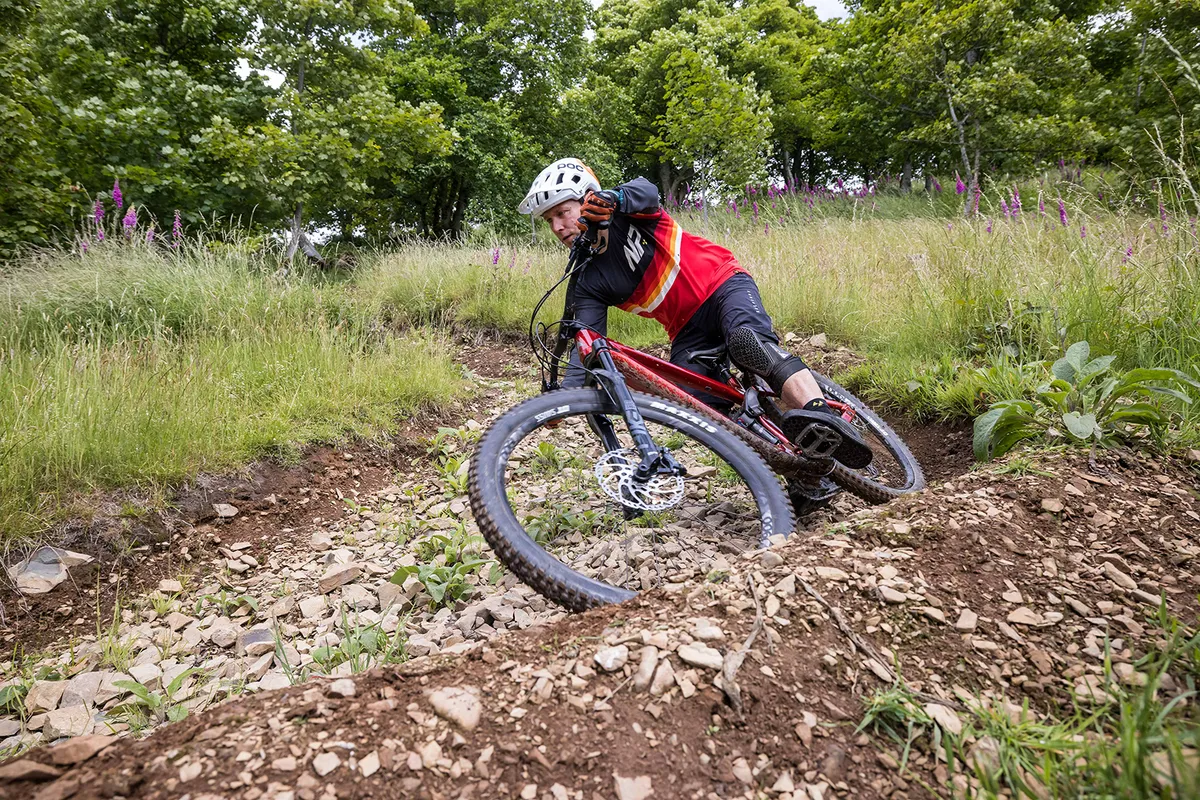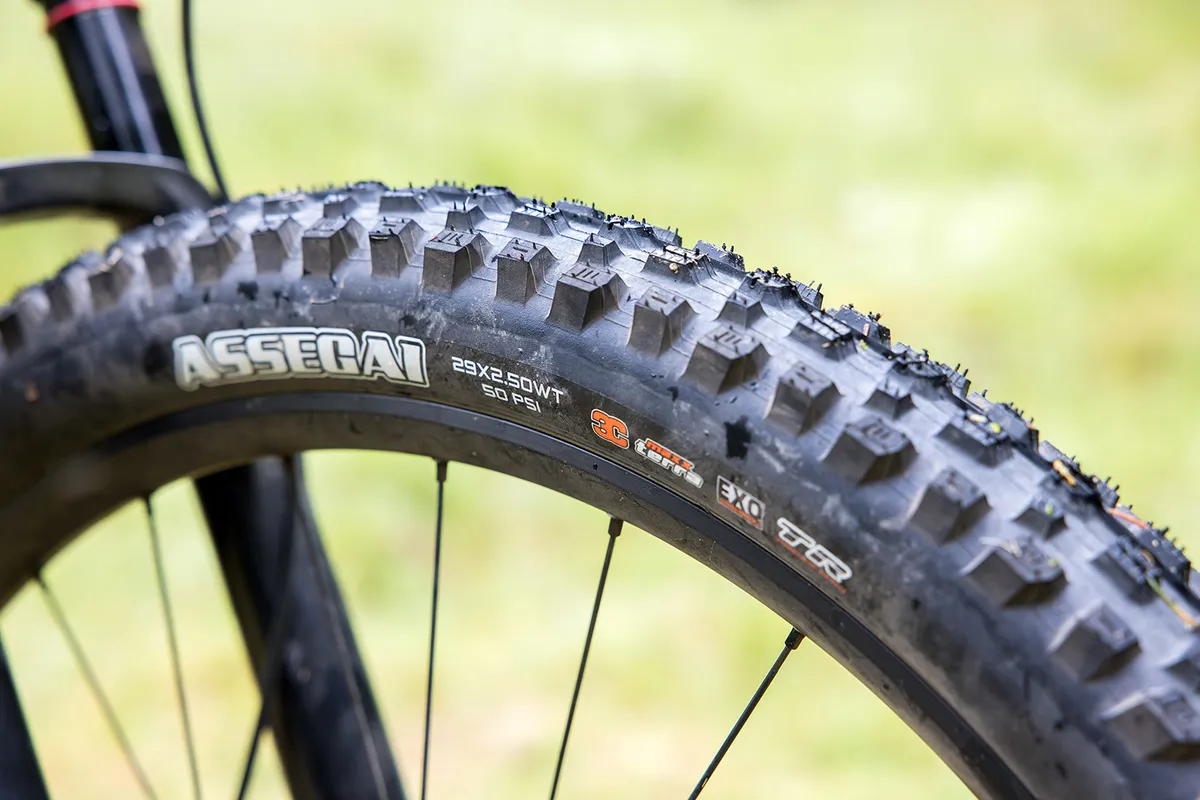Vitus always manages to spec incredible kit at reasonable prices; the buying power of owners CRC/Wiggle is immense, and us riders can reap the rewards.
The Escarpe is no exception, and the CRS version adds another feather to its bow in the form of a carbon front triangle. This 140mm-travel trail mountain bike certainly means business, with no significant downgrades elsewhere.
Vitus Escarpe 29 CRS details
- Top-dog spec: Given the Escarpe’s carbon fibre mainframe, you might expect downgrades elsewhere, but it comes with some great kit
- Chunky treads: Some brands chase a low headline weight figure by fitting skinny, thin-casing tyres, but not Vitus. It knows that no one likes punctures and that thicker casings also provide a more damped, controlled ride feel
- Damper delight: RockShox suspension is renowned for being easy to set up and the Pike fork and Deluxe shock on the Escarpe are no exception. It’s worth getting hold of some volume spacers to help tune them in for you, though
Vitus Escarpe 29 CRS frame, geometry and suspension details
Recently updated, the Escarpe has a new T700 carbon mainframe, paired with a 6061-T6 alloy rear end. Vitus claims that mixing these materials gives the best balance of frame stiffness and compliance.
Cables are routed internally from front to back, you get a bottle cage mount inside the front triangle, and there’s inbuilt chainstay and seatstay protection, plus a rock-strike guard on the underside of the down tube.
A more generous seatpost insertion depth than on the outgoing bike allows longer-travel dropper posts to be used, too.
There’s 140mm of rear-wheel travel, courtesy of Vitus’s four-bar Horst-link setup, which it's tweaked to increase small bump sensitivity, mid-stroke support and bottom-out resistance, and improve pedalling efficiency.
It's updated the geometry, too, taking the long, low and slack route. My large bike had a 478mm reach, 440mm seat tube, 440mm chainstays and 1,249mm wheelbase. The 77.5-degree effective seat tube angle was the steepest I had on test.
| | S | M | L | XL |
|---|---|---|---|---|
| Seat angle - effective (degrees) | 77 | 77 | 77.5 | 78 |
| Seat angle - actual (degrees) | 72 | 72 | 72 | 72 |
| Head angle (degrees) | 65 | 65 | 65 | 65 |
| Chainstay (mm) | 440 | 440 | 440 | 440 |
| Seat tube (mm) | 380 | 410 | 440 | 480 |
| Top tube (mm) | 566 | 596 | 619 | 643 |
| Head tube (mm) | 100 | 110 | 120 | 130 |
| Bottom bracket drop (mm) | 35 | 35 | 35 | 35 |
| Wheelbase (mm) | 1,188 | 1,218 | 1,249 | 1,281 |
| Stack (mm) | 617 | 625 | 634 | 643 |
| Reach (mm) | 437 | 451 | 478 | 505 |
A flip-chip changes the head angle by 0.5 degrees, from 65 to 65.5 degrees, and the bottom bracket drop by 6mm, from 35mm to 29mm. The Escarpe is also available with smaller 650b wheels with very similar geometry.
Vitus Escarpe 29 CRS specifications
The parts fitted to the Vitus stand out.
The Shimano SLX M7100 drivetrain doesn’t have the prestige of the Sonder EVOL's GX Eagle or the Focus Thron 6.9’s XT parts, but it works really well.
You also get SLX brakes, with a four-pot caliper and 203mm rotor up front for extra stopping power.
RockShox provides the suspension – a 150mm-travel RockShox Pike Select+ fork with Charger RC damper and a Super Deluxe Select+ metric-sized, trunnion-mounted shock.
The bike rolls on DT Swiss’s M 1900 wheels wrapped in triple-compound MaxxTerra Maxxis Assegai and Dissector tyres.
Aside from the 170mm-travel Brand-X Ascend XL dropper post, most of the other kit is from sibling brand Nukeproof, although on my test bike its Neutron saddle had been swapped for a WTB Volt.
This spec would be decent value for money on an alloy bike at this price and is incredible when you consider you’re getting a part-carbon frame, too.
Vitus Escarpe 29 CRS ride impressions

With its steep seat-tube angle, the Escarpe’s geometry puts your body in a neutral and natural feeling position on climbs, so I wasn't too far over the front putting excessive weight through my hands, and neither was I hanging off the back over the rear wheel.
Also thanks to its geometry, I wasn't constantly needing to reposition myself on the nose of the saddle to get more grip, making climbs a relaxing and comfortable affair. The seat tube angle also helped me get my hips over the top of the pedals, further improving the bike’s comfort.

The rear suspension is supple, absorbing the majority of trail chatter and boosting grip. It does this without bobbing excessively, even with the shock’s lockout lever in the ‘open’ position.
The Pike fork, which is fitted with RockShox’ newest DebonAir spring, wasn’t as supple as I was hoping. Although the new spring means the fork is less likely to suck into its travel (thanks to a redesigned negative air spring transfer port), I had to fill it with volume reducer tokens and decrease air pressure to get my desired levels of comfort and off-the-top smoothness.

Arguably, the fork wasn't as supple as the Fox 34 Rhythm or Cane Creek Helm MKII Air either. That said, the RockShox suspension was easy to set up, especially compared to the techy dampers on the Sonder EVOL's Cane Creek.
On the descents, not only did I have plenty of grip, but the suspension provided ample mid-stroke support and bottom-out resistance. This made the Vitus fun to ride and it was easy to generate speed over rough terrain where less of my energy was getting sapped by the rear end.
With a taut but not overly stiff feel, it egged me on to ride harder and faster.

One of our testers, who was running flat mountain bike pedals, found that the chainstays and seatstays were wide enough to catch on his heels with every crank revolution, resulting in paint scuff after one ride. This might not be a problem for everyone, however.
There was little to no chainslap, thanks to the inbuilt protector and the mech’s clutch mechanism, but there was some rattle from the internally-routed cables on rough terrain.
I've no complaints about the SLX drivetrain and brakes, with both offering reliable performance with a wide range of gears and plenty of stopping power. It’s impressive that Vitus has found room in the budget for DT Swiss wheels, too.
The Maxxis 3C MaxxTerra compound tyres helped build on the premium feel, but also offered great grip and damping in a host of different trail conditions, from bone dry to damp.
Vitus has specced the rear tyre with an EXO+ casing, offering extra puncture protection. This means the Escarpe can be pushed harder without the fear of flats or suffering from tyre roll caused by carcass instability.

While the 170mm post was the longest on test, without additional manual adjustment, it didn’t have quite enough drop to stop the saddle from contacting my bum on the steepest descents.
The geometry – that I left in the low position for the duration of the test – made for a calm descending experience, where the chassis was stable and composed right up until the trails got into downhill bike territory.
I didn’t feel like I was compensating for poor chassis configuration with excessive weight shifts either fore or aft, and was able to focus on having as much fun as possible.
Vitus Escarpe 29 CRS bottom line

Overall, the Escarpe impressed, with plenty of pop across a wide range of terrain, branded parts and a solid price tag. It’s a true one-bike quiver that’s ripe for upgrades.
How we tested
We put four do-it-all full-sus trail bikes, at the super competitive price point of £3,000, to the test on our local trails to find out which is the best you can buy right now.
Trail bikes are designed to handle everything from bridleway bashing to the odd uplift day, but categorising a trail bike by its geometry or suspension travel is becoming harder because bikes are getting lower, longer and slacker with more squish.
Generally, though, you should expect 130mm to 150mm of travel, plenty of standover room, a decent reach (the horizontal distance from bottom bracket to head tube, which affects how a bike feels when stood up on the pedals) and a stable head angle, between 64 and 66.5 degrees.
Also on test
Product
| Brand | vitus |
| Price | 4800.00 AUD,3800.00 EUR,2700.00 GBP,3300.00 USD |
| Weight | 14.9400, KILOGRAM (L) - without pedals |
Features
| Fork | RockShox Pike Select, 150mm (5.9in) travel |
| br_stem | Nukeproof Neutron, 45mm |
| br_chain | Shimano SLX M7100 |
| br_frame | T700 carbon fibre front triangle, 6061 aluminium alloy rear triangle, 140mm (5.5in) travel |
| Tyres | Maxxis Assegai 3C MaxxTerra EXO TR 29x2.5in (f), Maxxis Dissector 3C MaxxTerra EXO TR 29x2.5in (r) |
| br_brakes | Shimano SLX M7120, 200/180mm rotors |
| br_cranks | Shimano SLX, 30t |
| br_saddle | WTB Volt |
| br_wheels | DT Swiss M 1900 rims on DT Swiss 370 hubs |
| br_headset | Acros |
| br_shifter | Shimano SLX M7100 |
| br_cassette | Shimano SLX M7100, 10-51t |
| br_seatpost | Brand-X Ascend dropper, 170mm |
| br_gripsTape | Vitus lock-on |
| br_handlebar | Nukeproof Horizon, 780mm |
| br_rearShock | RockShox Deluxe Select+ DebonAir |
| br_bottomBracket | Shimano BB52 |
| br_availableSizes | S, M, L, XL |
| br_rearDerailleur | Shimano SLX M7100 (1x12) |




















